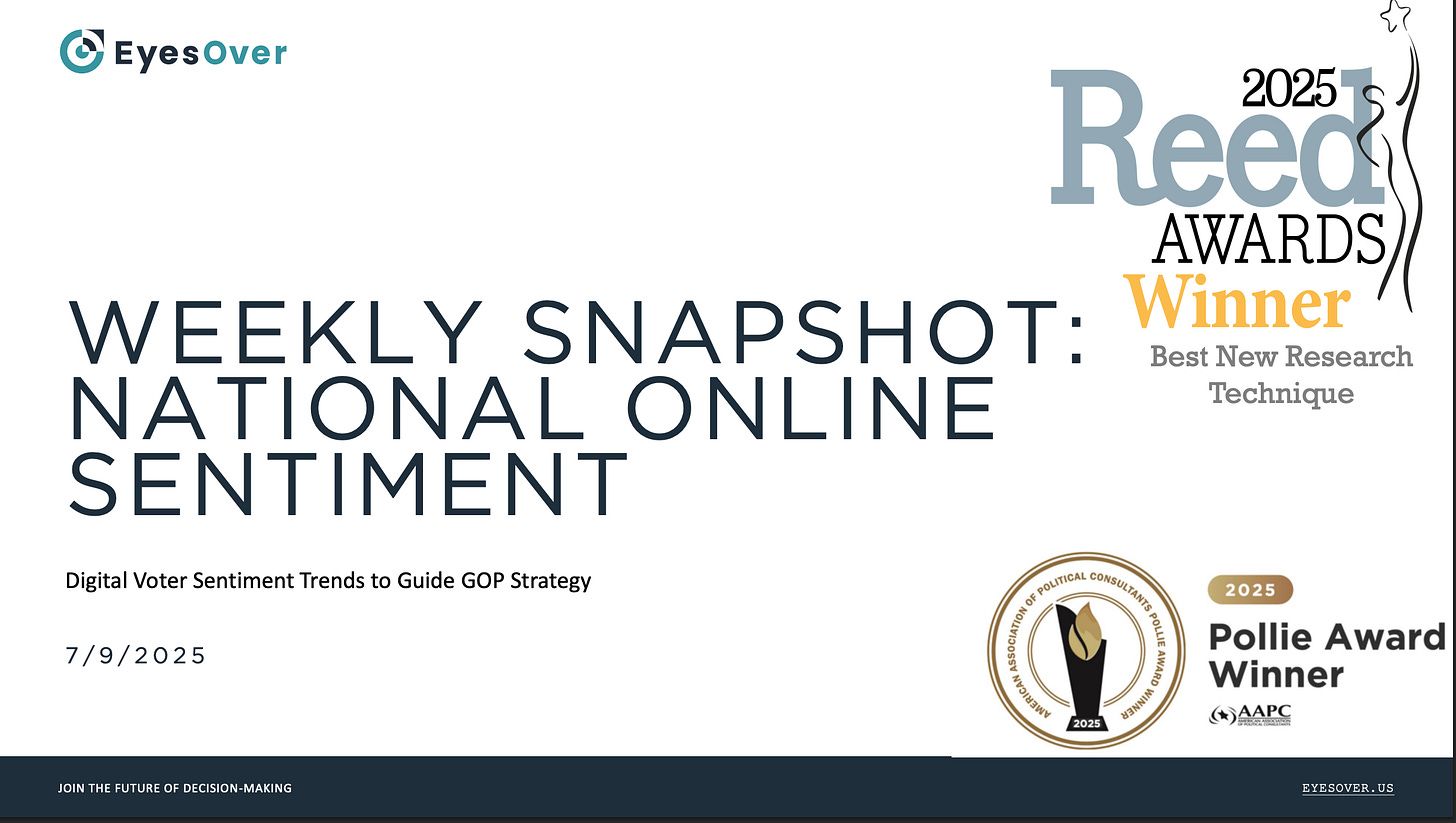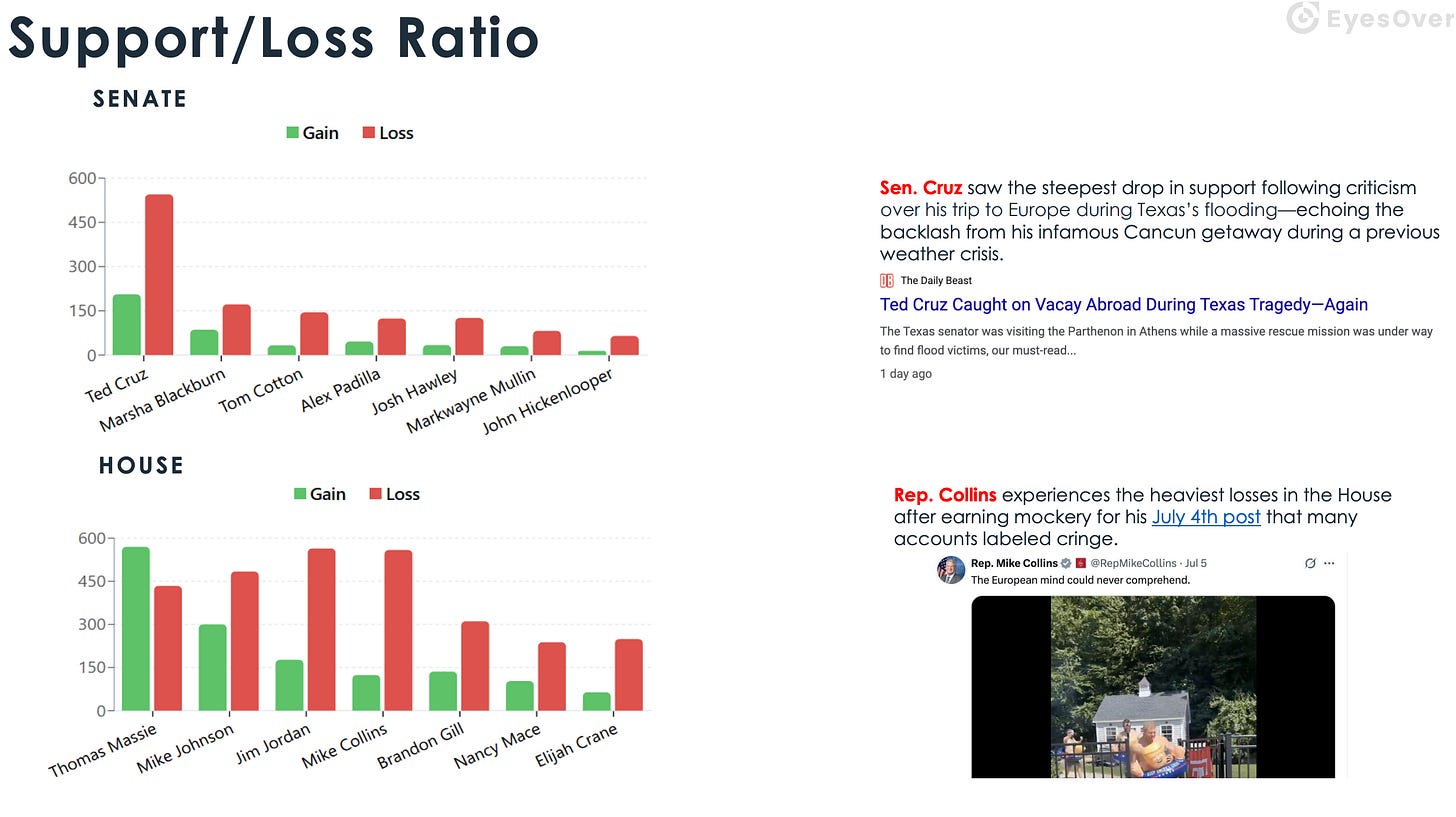Inside the Data War Room: How Smart Campaigns Will Win the Next Fight
Using Voter Sentiment Trends to Drive Messaging, Strategy, and Victory
We’re well past the era where polling was enough. In a digital-first world, understanding the real-time pulse of voter sentiment online is the key to winning.
This week’s EyesOver snapshot reveals how candidates, operatives, and PACs can use live sentiment analysis to gain an edge—and avoid pitfalls that could cost elections.
Here’s the strategic breakdown, page by page.
1. Medicaid Reform: Blue Wave Meets Red Wall
Key Insight:
While Democrats frame GOP Medicaid reform as cruel and unpopular, the data tells a more nuanced story: 35% of users defend the reforms, and GOP leaders aren’t seeing backlash if they message properly.
How to Use It:
For candidates in swing districts: Preemptively frame the bill using language that emphasizes fraud reduction and fiscal responsibility.
For PACs and consultants: Test messaging variants (“fraud” vs “fraud + work requirement”) to see which lands best with persuadable voters.
Supporting Research:
Academic work shows that issue framing significantly shapes public opinion (Chong & Druckman, 2007). Emphasizing fraud prevention appeals to moral foundations such as fairness and loyalty (Haidt, 2012).
2. House & Senate GOP Sentiment: What’s Really Moving the Base
Key Insight:
Sen. Cruz and Rep. Collins both suffered sentiment drops—not from policy, but from personal optics and social media misfires. Meanwhile, House GOP sentiment overall is up.
How to Use It:
Senate/House comms teams: Track personal brand sentiment in real time. Crisis comms should activate when drops are tied to viral moments.
Digital teams: Build dashboards that show when specific posts backfire. Even “patriotic” content (e.g., Collins’ July 4 tweet) can turn into a liability if miscalibrated.
Supporting Research:
Studies in political image management show that non-policy scandals or gaffes can erode public trust more rapidly than ideological disagreements (Nyhan, 2015).
3. Tucker Carlson’s Iran Interview: Sentiment Drivers in the New Right
Key Insight:
85% of online conversation about Tucker’s interview with Iran’s president was critical. Yet, within the minority support, themes like anti-globalism and anti-interventionism resonated with core conservative audiences.
How to Use It:
For issue-based influencers or surrogates: Lean into sovereignty and “America First” when discussing foreign policy—just not with adversarial regimes.
For media relations teams: Understand which audiences value the break from tradition vs. those who feel betrayed when journalists “go soft.”
Supporting Research:
Audience (market) segmentation theory (Wedel & Kamakura, 2000) explains why niche media tactics must align with tribal values to maintain credibility.
4. Trending Keywords: Political Timing in Real Time
Key Insight:
Top national keywords include “deportation,” “Israel,” and “Iran”—all trending with critical sentiment.
How to Use It:
For rapid response teams: Use this data to time messaging. Don’t wait for polling lag. Frame your issue before the public hardens its view.
For state parties: Customize your earned media pitches to reflect trending national topics in local language.
Supporting Research:
Agenda-setting theory (McCombs & Shaw, 1972-I know it’s old, but mass media is still mass media) shows that whoever defines the topic first often frames how it’s discussed. Social media has compressed this timeline to hours, not days.
5. Framing That Wins vs. Framing That Backfires
Key Insight:
Messaging that leans too heavily on buzzwords like “modernization” or backward-looking attacks (e.g., Afghanistan withdrawal) tends to fail. What works? Patriotism, law & order, and protection of everyday freedoms.
How to Use It:
For speechwriters: Replace jargon with vivid, emotional appeals. Speak to identity, not just policy.
For ad writers: Avoid rear-view mirror attacks. Make your case for the future, not the past.
Supporting Research:
Jonathan Haidt’s work on moral psychology shows that conservative audiences respond more strongly to loyalty, authority, and purity frames than abstract policy language.
6. Top Posts & Final Takeaways
Key Insight:
Posts that resonate with values—government accountability, national sovereignty, faith and family—drive the most engagement.
How to Use It:
For campaign digital teams: Use high-performing post themes to drive organic engagement. Mirror the tone and structure (imitation remains the purest form of flattery).
For allied influencers: Coordinate language and framing across ecosystems to saturate narratives.
Supporting Research:
The spiral of silence theory (Noelle-Neumann, 1974) indicates that the more frequently a message is seen, the more people believe it’s the dominant public view—even if sentiment was split to start.
Conclusion:
This isn’t just data—it’s a blueprint. In an era where one viral moment can cost an election, the EyesOver system doesn’t just react—it predicts. If you’re running a campaign, advising a PAC, or sitting in a war room, these insights aren’t optional. They’re foundational.
🔍 Want to sign up to get our weekly newsletter?








